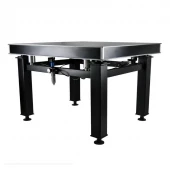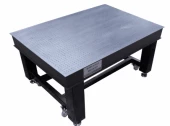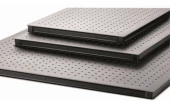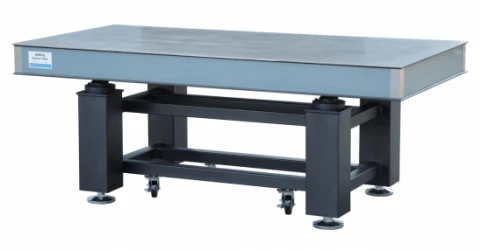Description
DRB series damping vibration isolation optical tables feature high rigidity, high stability, and good isolation performance thanks to B-type two elastomer dampers and rigid supports. The supports is in the form of a frame with casters, that let the optical table transport easily. The Stainless Steel tabletop has various sizes with a matrix of M6 threaded holes, it is convenient for mounting optical posts and rods. This series optical tables are suitable for normal experience applications.
DRB series Damping Vibration Isolation Optical Table
Specifications
| Table Material: | Stainless Steel |
|---|---|
| Hole Pattern: | M6 holes separated by 25mm |
| Table Length: | 600 mm |
| Table Width: | 600 mm |
| Table Thickness: | 50 mm |
| Flatness: | +/- 0.005 mm/mm^2 |
Features
- Resonant Frequency Range: Exceptionally low, between 7 to 20Hz, to minimize vibrations.
- Surface Flatness: Maintained at 0.1mm over a 600mm×600mm area, ensuring high precision for sensitive applications.
- Working Surface Material: Composed of 4-6mm thick SUS430 (1Cr17) stainless steel, known for its corrosion resistance and durability.
- Bottom Skin Construction: Made from 4-6mm thick carbon steel, providing robust support and stability.
- Variable Thickness Options: Available in 50mm, 100mm, 150mm, and 200mm thicknesses to accommodate different load requirements.
- Adjustable Height: Total height (including table top and supports) is 800mm with an adjustable range of -10mm to +15mm for versatile use.
- Mounting Hole Grid: Features a 25mm×25mm grid for flexible mounting options.
- Mounting Hole Borders: Designed with a 37.5mm border around the table for additional mounting flexibility.
- Mounting Holes: Equipped with M6 holes, standard for compatibility with a wide range of accessories.
- Weight Capacity: Varied depending on thickness, ensuring the table can support significant loads without compromising performance.
Applications
- Precision Instrumentation: Ideal for laboratories and research facilities where high-precision instruments require a stable platform free from vibrations.
- Microscopy: Essential in microscopy work, including electron and optical microscopy, where even minor vibrations can disrupt the imaging process.
- Optical Experiments: Used in optical experiments and setups that demand a vibration-free environment for accurate results.
- Laser Systems: Provides a stable foundation for laser systems used in cutting, engraving, and medical procedures, where precision is paramount.
- Semiconductor Manufacturing: Utilized in the fabrication and assembly of semiconductors where stability and precision significantly impact product quality.
- Material Science Research: Supports sensitive measurements and experiments in material science, including nano-scale and quantum research.
- Aerospace Engineering: Used in the design and testing of aerospace components where precision assembly and vibration isolation are critical.
- Acoustics Research: Provides an isolated platform for acoustic research and testing, where external vibrations could interfere with sound measurements.
- Biomedical Research: Essential for biomedical research and development, especially in areas like cell manipulation and microfluidics.
- Precision Engineering: Supports precision engineering tasks, including the assembly and testing of mechanical and electronic components where stability is crucial.
Frequently Asked Questions
What are the key features of the DRB series damping vibration isolation optical tables?
The key features of the DRB series damping vibration isolation optical tables are high rigidity, high stability, and good isolation performance.
What is the material used for the tabletop of the optical tables?
The tabletop of the optical tables is made of 4-6mm thick SUS 430(1Cr17) stainless steel.
What is the weight of the optical tables with different thicknesses?
The weight of the optical tables varies depending on the thickness: 50mm thickness - 110Kg/m2, 100mm thickness - 120Kg/m2, 150mm thickness - 130Kg/m2, 200mm thickness - 140Kg/m2.
What is the resonant frequency of the DRB series damping vibration isolation optical tables?
The resonant frequency of the DRB series damping vibration isolation optical tables is less than 7-20Hz.
How are the optical posts and rods mounted on the optical tables?
The optical tables have a Stainless Steel tabletop with a matrix of M6 threaded holes, which makes it convenient for mounting optical posts and rods.
Similar Products

GZT-009006 series Rigid Optical Vibration Isolation Test Table
Nanchang Leadtop Technology Co.,Ltd

Solid Aluminum Breadboards MOT-L with Light Weight Non-Magnetic and not Easy to Deform
Nanchang Leadtop Technology Co.,Ltd

ZDT-Pseries Tuned Damped Upgradable Optical Table with Pneumatic Isolation
Nanchang Leadtop Technology Co.,Ltd

POT-P Series Advanced Active Vibration Isolation Optical Table with Enhanced Isolators
Nanchang Leadtop Technology Co.,Ltd

ZDP Series Pneumatic Vibration Isolation Optical Table
Zolix Instruments CO.,LTD

ZTP Series Pneumatic Vibration Isolation Optical Table
Zolix Instruments CO.,LTD

DRP series Damping Vibration Isolation Optical Table
Zolix Instruments CO.,LTD

NTBH series Honeycomb Optical Breadboards
Zolix Instruments CO.,LTD

NTBB Series Stainless Steel Breadboard
Zolix Instruments CO.,LTD

OTSB Series Solid Aluminum Optical Breadboards
Zolix Instruments CO.,LTD
Thank You!
Your inquiry has been received.
Create an account by adding a password
Why create an account?
- Auto-complete inquiry forms
- View and manage all your past messages
- Save products to your favorites
- Close your account anytime — no hassle
